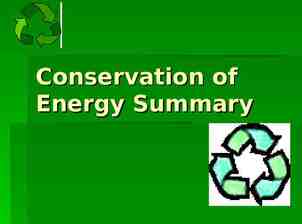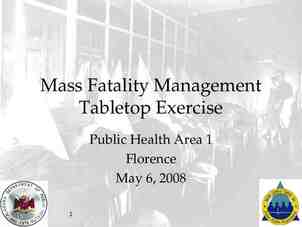Quantum Computing: from theory to practice Prabhas Chongstitvatana
80 Slides8.86 MB
Quantum Computing: from theory to practice Prabhas Chongstitvatana Faculty of Engineering Chulalongkorn University in collaboration with Chatchawit Aporntewan Department of Mathematics and Computer Science Chulalongkorn Unversity March 2018
You can get this presentation Search “Prabhas Chongstitvatana” Go to me homepage
What is a quantum computer? a computer that relies on special memory, "quantum bit", to perform massively parallel computing.
What is a quantum bit? a basic unit of memory that uses superposition of "quantum" effect (entanglement) to store information. a "qubit" stores the probability of information. It represents both "1" and "0" at the same time.
What is the advantage? It is very very fast compared to conventional computers It has very large memory, example 10-qubit is .
10 Qubits print(2**(2**10)) 17976931348623159077293051907890247336179769789423065727343008115 77326758055009631327084773224075360211201138798713933576587897688 14416622492847430639474124377767893424865485276302219601246094119 45308295208500576883815068234246288147391311054082723716335051068 4586298239947245938479716304835356329624224137216
Introduction and Overview Quantum mechanics is a mathematical framework or set of rules for the construction of physical theories. From “classical physics” to “quantum mechanics” ultraviolet catastrophe see the video: A Brief History Of Quantum Mechanics https://www.youtube.com/watch?v B7pACq xWyw 5000 K 4726.85 C 4000 K 3726.85 C 3000 K 2726.85 C
Computer Science Church–Turing thesis (Alan Turing & Alonzo Church, 1936) Any algorithmic process can be simulated using a Turing machine. Electronic computers (John von Neumann) Transistors (William Shockley) Moore’s law (Gordon Moore) Computer power will double for constant cost roughly once every two years. (should end in 21st century, moving to a different computing paradigm) A classical computer can simulate a quantum computer, but it is not “efficient.” Strong Church–Turing thesis Any algorithmic process can be simulated efficiently using a Turing machine. (People have tried to find a counter example, for instance, primality) Randomized algorithms (an ad-hoc version of strong Church–Turing thesis) Any algorithmic process can be simulated efficiently using a probabilistic TM. David Deutsch used quantum mechanics to derive a stronger version. Any physical system can be simulated efficiently using a quantum computer. (the proof is ongoing).
https://www.youtube.com/watch?v E3keLeMwfHY
Computer Science (continue) A problem/algorithm that can be solved/executed efficiently on QC, but not on TM Deutsch algorithm Deutsch-Jozsa algorithm Grover’s algorithm Shor’s algorithm Feynman had pointed out that there seemed to be essential difficulties in simulating quantum mechanical systems on classical computers, and suggested that building computers based on the principles of quantum mechanics would allow us to avoid those difficulties.
Quantum Bits (Qubits) Classical bits vs. Quantum bits Qubits are mathematical objects (similarly to 0/1 in classical bits) Prob. Prob.
Particles ¿𝟏𝟎 ⟩ 4x1 matrix ¿ 𝟏 ⟩ 2x1 matrix ¿𝟎𝟏 ⟩ ¿𝟎𝟎 ⟩ ¿𝟎⟩ ¿𝟏𝟏 ⟩ อ่านว่า Ket A มาจาก Dirac’s notation (Paul Dirac)
Waves 3 1 𝑖 2 1 2 𝑖 3 1 𝑖 2 1 2
Quantum Bits (Qubits) ซาย ฟาย (ฟี) Measurement
Single Qubit Gates NOT Unitary matrix
Single Qubit Gates Z gate: H gate (Hadamard):
Multiple Qubit Gates
Reversible / Invertible Classical XOR and NAND are irreversible or non-invertible. Qubit gates are always reversible (there are always inversed matrices). The inverse of U is the adjoint of U. Universality “Any multiple qubit logic gate may be composed from CNOT and single qubit gates.” Similarly, any multiple classical logic gate may be composed from NAND gates.
Measurements in bases other than the computational basis Change basis from 0 , 1 to , -
Circuit swapping two qubits Wire the passage of time Acyclic No FANIN No FANOUT
Classical computations on a quantum computer Write an 8x8 matrix of Toffoli gate.
Simulating NAND gate and FANOUT How to produce a random number?
Quantum Parallelism
The Power of Quantum Computation P solved in polynomial time NP verified in polynomial time PSPACE solved in polynomial space We do not know whether P ! NP PSPACE is bigger than NP NP-complete Graph isomorphism Integer Factorization BQP (bounded error quantum polynomial time) is the class of decision problems solvable by a quantum computer in polynomial time, with an error probability of at most 1/3 for all instances.
Further Reading รูปเป็นเพียงจินตนาการ ไม่มใี คร ทราบว่า electron spin หน้าตาเป็น อย่างไร? ดูวด ี ีโอ น. 15 จะเข้าใจมากขึ้น http://www-bcf.usc.edu/ tbrun/Course/lecture02.pdf
Quantum Computer
Linear optics quantum computing (LOQC) Experimental setup to generate up to four entangled photons. These photons are typically entangled in polarization and can be further manipulated by simple optical devices. Recently a four-photon cluster state was realized with this setup. http://homepage.univie.ac.at/robert.prevedel/test research LOQC.html
Beam Splitter Inverse Reflect R Transmit 1 – R
Quantum Optical Fredkin Gate ข้อสอบ: อธิบายว่าวงจร optical นี้ทำงานเป็น Fredkin Gate ได้ยง ั ไง?
How to make a quantum bit? "quantum effect" photon entanglement cold atom electron spin
Quantum computers: physical realization
Quantum circuits
Quantum circuits
AN Approach to build quantum computers
Large array of ion-trap system
Example of quantum computers ibm 5 qubits D-wave two, quantum annealing
Recent work google quantum lab's paper claim of 100,000,000x speed up
IBM 5 qubits processor
Google Nasa, D-Wave 2x machine
IBM 50 qubits quantum computer
Atomic clock The heart of an optical atomic clock is a highly stable reference frequency provided by a narrow optical absorption in an atom or ion. NPL is developing optical frequency standards based on transitions in single trapped ions of strontium and ytterbium, and neutral strontium atoms confined in an optical lattice.
Programming Quantum Computers
Quantum algorithms computer programs that work on quantum computers
Famous algorithms Shor's integer factorization Given an integer N, find its prime factors
Quantum Algorithms 1994 Peter Shor a quantum algorithm for integer factorization formulated .
Shor’s algorithm The factorization also needs huge amount of quantum gates. It increases with N as (log N)3. Thus factoring of a 4096-bit number requires 4,947,802,324,992 quantum gates.
In 2001, Shor's algorithm was demonstrated by a group at IBM, who factored 15 into 3 5, using an NMR implementation of a quantum computer with 7 qubits. In April 2012, the factorization of 143 was achieved, although this used adiabatic quantum computation rather than Shor's algorithm. In November 2014, it was discovered that this 2012 adiabatic quantum computation had also factored larger numbers, the largest being 56153.
My own example of quantum computation compact genetic algorithm by quantum computers exponential speedup
Normal 1) initialze qureg x 2) generate two individuals from qureg 3) let them compete 4) update qureg x with the winner 5) repeat step 2.4 for k times 6) generate the final result
quantum speedup 1) initialze qureg x 2) generate the first individual from qureg x 3) generate the second individual with condition that fitness is greater than the first 4) let them compete 5) update qureg x with the winner 6) repeat step 2.5 for k times 7) generate the final result
output
output
Quantum computer language
Simon Gay’s Bibliography (U. of Glasgow)
QCL
User defined function
Update on Qubit Construction
Looking into the future Studying quantum computer give rise to new ideas Quantum “thinking” promises a new kind of method to solve really difficult problems We don’t know whether the effort in building quantum computer will bear any practical results But we do know that it will change the face of computing forever
References Yingchareonthawornchai, S., Aporntewan, C., and Chongstitvatana, P., "An Implementation of Compact Genetic Algorithm on a Quantum Computer," Int. Joint Conf. on Computer Science and Software Engineering (JCSSE), 30 May - 1 June 2012, pp.131-135. http://www.cp.eng.chula.ac.th/ piak/paper/2012/jcsse-quantum-cga.pdf Cold matter, assemble atom by atom https://arxiv.org/abs/1607.03044 Optical Atomic Clock http://www.npl.co.uk/science-technology/time-frequency/research/ optical-frequency-standards/
More Information Search “Prabhas Chongstitvatana” Go to me homepage





















































































